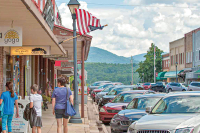The butternut is a country boy’s tree
“A countryman’s tree is the Butternut, known to the farm boy but not his city cousin. One who takes thoughtful walks in the woods may come to know and admire it for the grand old early American it is.”
— Donald Culross Peattie, A Natural History of Trees (1949)
Unlike herbaceous plants or shrubs or vines, trees display an almost human presence. Each has unique characteristics, a spirit of its own. I enjoy visiting trees. One of my best friends is a basswood tree that resides down the creek from my house. This tree has resided on “our” property for at least three times as long as I have. Its ancestors were here long before the first Indians arrived.
I don’t have a favorite tree any more than I have a favorite bird or wildflower. But I am partial to several species: basswood, oaks, deciduous magnolias, yellow birch, Fraser fir and butternut walnut.
Of these, the ones that stand out in winter are Fraser fir (because it’s an evergreen) and butternut walnut (because of its bark). I spot butternut walnut a lot easier when the leaves are off the trees because the distinctive gray to light brown bark is almost luminous in winter light. The bark is divided into deep furrows that form a characteristic gray diamond-shaped pattern.
Here in the Smokies region, butternut walnut (also known as white walnut) grows in rich woodlands at low and middle elevations, especially on moist, well-drained slopes or alongside streams. Butternut walnut is shorter than its cousin the black walnut, but its branches spread more. The leaflets of a butternut walnut leaf are wider and fewer than those on black walnut, and the latter often lacks a terminal leaflet. Another distinction is that the nuts of butternut walnut are egg-shaped and become a yellowish-brown at maturity. But once you learn to recognize the diamond-shaped bark, you’ll identify it with ease.
Related Items
Butternut walnut is yet another of our threatened trees. Charles E. Little provides details in The Dying of the Trees: The Pandemic in America’s Forests (1995): “The proximate cause of butternut mortality is a canker, first identified in 1967 on the East Coast, but not much recognized for another 20 years as the serious problem it was to become. The butternut canker is now found throughout the tree’s range … The canker — a ‘sore’ caused by the fungus — begins as a tiny spore entering the tree through an injury to a limb, twig, or trunk. Then the lens-shaped cankers, necrotic lesions of the bark and cambrium layer, spread throughout the tree, even to the nut husks, eventually girdling the main limbs and trunk and causing the tree to die … At the Great Smoky Mountains National Park, NPS scientists have been working with canker-inflicted butternuts since 1987, having identified some 70 trees that they keep track of. Many have since died, but even among those living, the rate of reproduction of the butternut has fallen to near zero. The NPS is now collecting `scions’ — detached shoots — from the trees that are left, in a near-hopeless effort to find a canker-resistant genotype.”
The Cherokees used the bark of butternut walnut to make various medical remedies, and they collected the nuts as food. To this day, it is the tree they favor as the dye source for the lustrous brown color of their basket splints.
White mountaineers used the inner bark and fruit husks to obtain a yellow or orange agent to dye their homespuns. During the Civil War, backwoods Confederate troops dressed in homespun “uniforms” of butternut-dyed cloth became known as “Butternuts.” Some ginseng hunters seek out butternut trees on moist slopes as a way of locating choice ginseng sites. Some local cabinetmakers and carvers favor butternut wood, which is softer and lighter in color than black walnut.
“In an old country church somewhere in the Southern mountains … if the altar is carved of a lustrous and satiny wood, a light brown with bands of paler sapwood, it might well be made of butternut walnut,” Charles E. Little noted.
There are several butternut walnuts down the creek from my house. I say hello to them whenever I’m on my way to visit with my friend the basswood tree.
Unlike the basswood tree, the butternuts are sick. When I first got to know them a quarter of a century ago, they seemed in perfect health. Now the cankerous lesions are eating them alive. Their days are numbered.
George Ellison wrote the biographical introductions for the reissues of two Appalachian classics: Horace Kephart’s Our Southern Highlanders and James Mooney’s History, Myths, and Sacred Formulas of the Cherokees. In June 2005, a selection of his Back Then columns was published by The History Press in Charleston as Mountain Passages: Natural and Cultural History of Western North Carolina and the Great Smoky Mountains. Readers can contact him at P.O. Box 1262, Bryson City, N.C., 28713, or at This email address is being protected from spambots. You need JavaScript enabled to view it..









